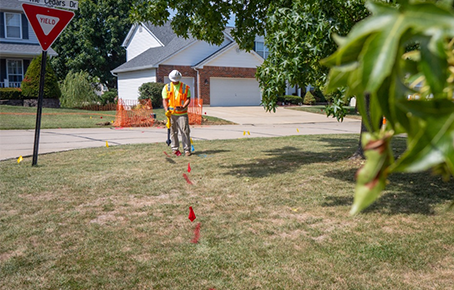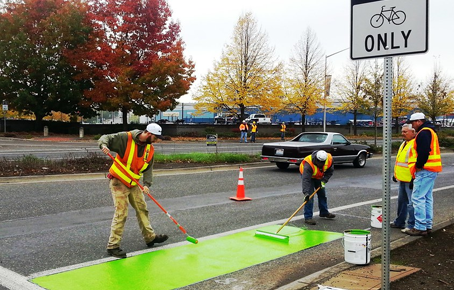The Ultimate Guide to Parking Lot and Road Striping Paints: Choosing the Right Solution for Durability and Safety
Ensuring clear and durable pavement markings is crucial for safety and organization in both parking lots and on roadways across the country. The right parking lot striping paint or road striping paint, also known as traffic paint, plays a vital role in guiding vehicles, defining parking spaces, marking pedestrian walkways, and communicating essential traffic instructions. This comprehensive guide will delve into the different types of traffic paint available, their applications, key considerations for selection, and best practices for achieving long-lasting and highly visible results.
Understanding the Different Types of Traffic Paint
The world of parking lot striping paint and road striping paint offers a variety of formulations, each with unique properties and benefits. Understanding these differences is essential for choosing the optimal product for your specific needs in your climate and traffic conditions.
Acrylic Pavement Paint
Acrylic paint can typically be washed with water, so no special solvent is needed (cheaper clean-up). Acrylic emulsion paints are fast drying and form a water-resistant film after they dry. The acrylic emulsion is an added process for the paint which improves abrasion resistance as well as added resistance to fungi and algae. The emulsion process also helps to make it easier to clean.
Some acrylic pavement paints have an additional designation of ‘fast dry’. Fast dry paints are made to be dry to the touch in about 5 minutes, and ready for traffic in about 15 minutes. Although there are benefits to faster drying, there is one drawback. Some equipment will not work well with ‘fast dry’ because the paint dries too quickly. So be sure to check the paint requirements for the application device you are using.
Water based paints like acrylics are best applied in temperatures above 50 degrees.
- Low VOC Acrylic Traffic Paint: Often considered the best parking lot striping paint for many applications, acrylic low VOC-based paints are known for their fast drying times, low VOC (Volatile Organic Compounds) content, and ease of application and cleanup. They are a more environmentally friendly traffic paint option and offer good durability for parking lots with moderate traffic.
- Fast Drying Acrylic Traffic Paint: For high-traffic roadways and areas requiring exceptional durability, fast-drying acrylic high solids paint is your best choice. This acrylic traffic paint offers a good balance of durability, drying time, and ease of application for both parking lots and roadways. These paints offer excellent adhesion and resistance to wear and tear, chemicals, and weathering. While they may have higher VOC content compared to other options, their longevity often makes them a cost-effective solution for demanding environments.
Thermoplastic Paint
This type of road striping paint is applied in a molten state and creates a very durable and long-lasting marking. Thermoplastic road marking paint is often used on highways and major roadways due to its excellent retroreflectivity (when combined with glass beads) and resistance to heavy traffic. It requires specialized road striping equipment for application. Thermoplastic paints have two different application methods: hot and cold. Thermoplastic paint contains plastic that makes it a very durable paint for intense traffic areas. Thermoplastic paint is also more expensive than regular water-based paints, though. Typically, thermoplastic paint requires a solvent for clean-up which is an added cost to consider.
Cold-applied liquid thermoplastic marking paint can be applied with standard airless spray equipment. Hot-applied thermoplastic requires either a “Torch” or “Melter” application which calls for special equipment and added cost. The advantage to hot-applied is that the finished coat can stand up to years of traffic.
Reflective Paint
Reflective paint generally refers to the addition of glass beads to the paint after it is sprayed. This provides higher reflectivity at night. This process is often used for striping road lines. The glass beads can be applied by sprinkling the beads over the over wet paint by hand, or you can use a glass bead dispenser. The reflectivity of airport pavement markings are particularly vital. You can read more about the Federal Aviation Administration’s (FAA) study on airport markings – paint and bead durability study.

Common Uses of Traffic Paint
Traffic paint serves as a fundamental tool for communication and organization across a wide range of environments, primarily focused on guiding vehicular and pedestrian movement and indicating specific regulations or hazards. One of its most prevalent applications is in parking lots, where it is used to delineate individual parking spaces, creating order and maximizing the number of vehicles that can be accommodated safely. Other applications include:
Key Considerations When Choosing Parking Lot and Road Striping Paint
Selecting the right traffic paint involves several important factors to ensure optimal performance and longevity in your specific environment. The amount and type of traffic (cars, trucks, heavy machinery) will significantly impact the required durability of the paint. High-traffic areas demand more robust formulations like solvent-based or thermoplastic options. The type of pavement (asphalt, concrete) can influence paint adhesion. Ensure the chosen paint is compatible with the surface material.
You will also want to consider other factors when choosing your paint, such as:
- Climate and Weather Conditions: If you live in a place that experiences a range of temperatures and weather conditions, choose a paint that can withstand temperature fluctuations, rain, snow, and UV exposure.
- Drying Time: Consider the disruption to traffic flow during application. Fast drying traffic paint options are ideal for minimizing downtime.
- Visibility Requirements: For nighttime visibility and safety, especially on roadways, reflective traffic paint is essential. This can be achieved by incorporating glass beads into the paint or applying them immediately after application.
- Durability and Longevity: The lifespan of the paint is a key economic consideration. Investing in a long-lasting parking lot paint or durable road marking paint can reduce the frequency of re-striping.
- Environmental Regulations: Be aware of local and federal regulations regarding VOC content and choose environmental friendly traffic paint options when possible.
- Color Requirements: Parking lot paint colors are typically white and yellow, but other colors may be used for specific markings like handicap spaces or loading zones. Road line paint colors are standardized for clear communication.

How Do I Apply Traffic Striping Paint?
Ensure the pavement is clean, dry, and free of debris, oil, and loose material. Proper cleaning is essential for good adhesion. Apply paint within the manufacturer's recommended temperature range and avoid application during rain or when rain is expected.
Make sure to use the appropriate road striping equipment, such as airless sprayers or walk-behind stripers, for even and consistent application. Apply paint in consistent widths and straight lines. Use stencils for symbols and markings. If using reflective traffic paint or adding beads separately, ensure even distribution for optimal nighttime visibility.
Allow sufficient drying or curing time as recommended by the manufacturer before allowing traffic on the newly painted surfaces.
If you are working in a temporary construction or work zone, you may wish to consider using pavement tape. This foil-backed marking tape allows you to easily install it by hand with no special tools or equipment.
How To Use Parking Lot Striping Stencils
Using parking lot striping stencils can help you achieve crisp, professional-looking markings in your parking lot. These templates ensure uniformity and precision for essential markings like handicap symbols, directional arrows, visitor parking designations, and reserved space indicators. Thorough preparation of your pavement surface is crucial for optimal stencil adhesion and clean lines. Sweep away all dirt, debris, and loose particles, ensuring the surface is completely dry. Carefully plan the layout of your parking lot markings, referring to local regulations and your desired traffic flow. Use a measuring wheel or tape measure to accurately mark the placement of each stencil, considering factors like parking space size, aisle width, and accessibility requirements.
Properly securing your stencil is essential to prevent movement during paint application. Use weights such as sandbags or bricks placed along the edges to hold it firmly. For a more secure hold, consider using a temporary, low-tack spray adhesive designed for stencils. When applying paint, choose a high-quality parking lot striping paint appropriate for your surface and traffic volume. If using aerosol spray paint, apply thin, even coats using a consistent sweeping motion. If using a roller, gently roll the paint over the stencil openings, ensuring complete coverage without excessive pressure. Work from the outer edges of the openings inward to prevent paint from being pushed underneath the stencil.
Remove the stencil while the paint is still slightly wet but no longer tacky to prevent sticking and potential paint pull-up. Clean your parking lot stencils immediately after each use with the appropriate solvent to prevent paint buildup.
View all of our pavement marking and striping products online > >




